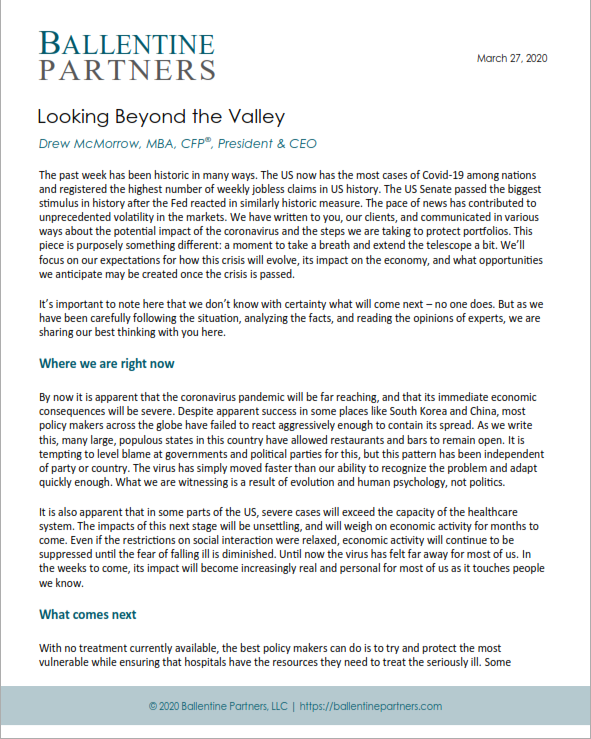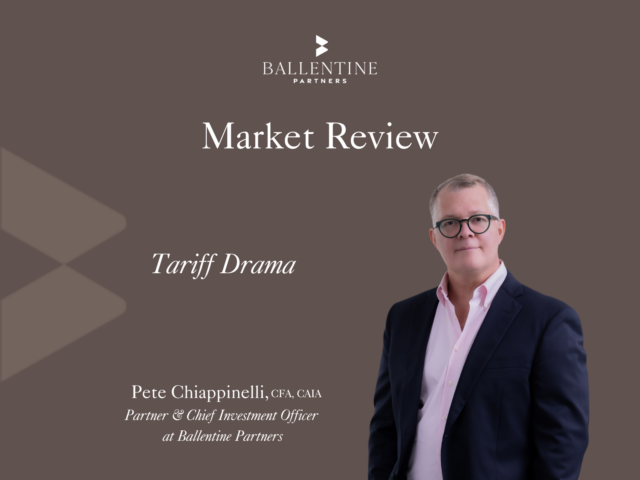The past week has been historic in many ways. The US now has the most cases of Covid-19 among nations and registered the highest number of weekly jobless claims in US history. The US Senate passed the biggest stimulus in history after the Fed reacted in similarly historic measure. The pace of news has contributed to unprecedented volatility in the markets. We have written to you, our clients, and communicated in various ways about the potential impact of the coronavirus and the steps we are taking to protect portfolios. This piece is purposely something different: a moment to take a breath and extend the telescope a bit. We’ll focus on our expectations for how this crisis will evolve, its impact on the economy, and what opportunities we anticipate may be created once the crisis is passed.
It’s important to note here that we don’t know with certainty what will come next – no one does. But as we have been carefully following the situation, analyzing the facts, and reading the opinions of experts, we are sharing our best thinking with you here.
Where we are right now
By now it is apparent that the coronavirus pandemic will be far reaching, and that its immediate economic consequences will be severe. Despite apparent success in some places like South Korea and China, most policy makers across the globe have failed to react aggressively enough to contain its spread. As we write this, many large, populous states in this country have allowed restaurants and bars to remain open. It is tempting to level blame at governments and political parties for this, but this pattern has been independent of party or country. The virus has simply moved faster than our ability to recognize the problem and adapt quickly enough. What we are witnessing is a result of evolution and human psychology, not politics.
It is also apparent that in some parts of the US, severe cases will exceed the capacity of the healthcare system. The impacts of this next stage will be unsettling, and will weigh on economic activity for months to come. Even if the restrictions on social interaction were relaxed, economic activity will continue to be suppressed until the fear of falling ill is diminished. Until now the virus has felt far away for most of us. In the weeks to come, its impact will become increasingly real and personal for most of us as it touches people we know.
What comes next
With no treatment currently available, the best policy makers can do is to try and protect the most vulnerable while ensuring that hospitals have the resources they need to treat the seriously ill. Some treatments may be available by early summer, but early indications are that they will be of limited efficacy. Nevertheless, outcomes should improve as hospital capacity increases. This, coupled with new cases peaking as the current restrictions take effect, will allow policy makers to begin the delicate balancing act of trying to restart the economic engine without overwhelming our capacity to treat the sick. Intermittent and regional “shutdowns” of different natures and lengths are likely to become normal as this phase of the fight unfolds. If warm weather does indeed slow transmission as some expect, the summer would see improved economic activity as we prepare for an expected resurgence in the fall.
Later this year, a new phase in the fight, and an entirely new version of “normal” should begin. As antibody tests become available, indicating who has immunity and who does not, we expect that restrictions on gathering will gradually lessen. Such tests are actually easier to develop than testing for the virus itself, and may even be available for home use. After the first wave of the disease has swept through, and many people have acquired immunity, there is likely to be a new societal version of “have and have-nots”. People with immunity will be able to resume their normal routines, while the rest will struggle with difficult choices. Transmission rates would fall as the virus finds fewer hosts, allowing governments to ease restrictions more often. This phase would likely last until a vaccine is tested in large human trials and is ready for mass production and distribution. Although optimistic estimates of that timing are in the range of 12-18 months, not much attention has been given to the outer ranges of those estimates. It is quite conceivable that the “new normal” we describe could go on for twice that or longer.
There are many uncertainties associated with the scenario above. The virus could mutate, a treatment could be better than we expect, a vaccine ready faster. We could become more facile at testing, tracking, and containing. Transmission rates could simply slow in response to our changing behavior in ways that epidemiologists struggle to predict. Alternatively, it is also possible that this first wave could be much faster and greater than we expect, but then providing immunity to many more in a second phase. Immunity could prove to be temporary as some scientists fear. All of these are scientifically plausible possibilities, but the above represents our best understanding of consensus thinking in the scientific community.
Initial economic consequences
The short-run economic shocks are substantial and on par with the events of 1929 and 2008. As in past recessions, GDP will contract substantially, unemployment will rise, and corporate earnings will fall. We believe the pace of the rebound will be disappointing at first, based on our assessment of how economic activity will be hindered by the virus. The effects of massive stimulus and loan guarantees will save certain vulnerable industries such as the airline industry until the economy improves. We believe the banking sector is in far better shape to endure a wave of credit losses than it was in the last crisis. Because of the aggressive actions of the Fed, market liquidity will be less of a problem than it was in past recessions, which will ultimately leave the economy poised for a strong rebound when the virus is subdued.
Although the economy and the stock market are inextricably linked in the long run, investor psychology and market sentiment play an outsized role in the short term. As a result, while the economic consequences seem more predictable, the timing of the recovery in the stock market remains highly uncertain.
Longer-term implications
As we consider what the world will look like beyond the valley, we are thinking about how investment portfolios should be realigned to benefit from this new reality. While far different than our current predicament, we can draw some conclusions from how our country responded to recent past crises.
Politically, we have a long history in the US of responding very well to the last crisis. After 9/11, we launched two wars and built a sophisticated intelligence infrastructure focused on rooting out potential terrorists. After the financial crisis, we imposed more regulation on banks – restrictions that helped them arrive at this crisis with stronger balance sheets. After this, we expect our CDC to become stronger, with much better pandemic response capabilities. Our health care infrastructure and related supply chains will also likely improve.
The coronavirus will leave lasting imprints on the psychology and behavior of society, which will consequently create, and in some cases accelerate, economic and industrial trends. A new culture of remote work is emerging, enabled by distributed communication technology, which should change many sectors of the economy. This trend will likely accelerate adoption of many technologies, such as 5G. For other sectors, such as commercial real estate and automobiles, this change could be a setback as there are fewer commuters.
The process by which our citizenry is educated is likely to undergo dramatic change as the acceptance of remote learning accelerates. This could have material effects on our institutions of higher learning, and perhaps an end to spiraling tuition costs. We are hopeful that it could broaden opportunities for many people for which a college education was previously unaffordable.
A boost in public investment in health care will likely fuel new successes in the next decade, as will a new generation of recruits to the industry after they are, quite justly, regaled as heroes for their part in fighting the pandemic. Traditional retail will continue to decline as more consumers turn to home deliveries for all kinds of goods. The implications of this will be sobering for owners of commercial real estate, but lower lease rates should help many service industries, and restaurants, rebound.
For those clients with adequate capital and liquidity, the greatest opportunities over the next few years may be in private equity and direct investing. The pandemic will badly damage many smaller companies that have good long-term prospects but lack sufficient capital to survive. The magnitude of this need will force owners to accept terms less favorable to them than in the past, creating the possibility for extraordinary returns for providers of both equity and debt capital. Opportunities in health care and technology will fuel returns in this space in the post-pandemic decade.
Arguably, the pandemic is accelerating the rise of China and its global influence, despite it being the country of origin. The initial outbreak revealed to the world the extent of China’s economic importance, as supply chain disruptions fueled initial stock losses. The nature of their Communist system and the social control it permits aided their ability to beat back the virus relatively quickly. As they now come to the aid of other nations, it is apparent that China’s influence in the world is growing. While there may be some economic damage as some US companies seek to reorient their supply chain capabilities away from China in response, we believe that China, and the emerging Asia nations in general, will grow even more quickly in the post-pandemic decade. For Europe, on the other hand, the pandemic exacerbates and accelerates structural issues of public debt and employment, further weakening their prognosis for growth.
As stewards of our clients’ capital, we must consider the longer-term implications of this deadly pandemic. Yet, it would be highly insensitive to not acknowledge the suffering and hardship that the coronavirus is imposing on the safety and well-being of the world’s population, particularly the poor, the sick, and the elderly. Although we are at an inflection point in our history, we are confident in the resilience of our society to reach the other side of the valley.
Learn more about Drew McMorrow, our President & CEO.
This report is the confidential work product of Ballentine Partners. Unauthorized distribution of this material is strictly prohibited. The information in this report is deemed to be reliable but has not been independently verified. Some of the conclusions in this report are intended to be generalizations. The specific circumstances of an individual’s situation may require advice that is different from that reflected in this report. Furthermore, the advice reflected in this report is based on our opinion, and our opinion may change as new information becomes available. Nothing in this presentation should be construed as an offer to sell or a solicitation of an offer to buy any securities. You should read the prospectus or offering memo before making any investment. You are solely responsible for any decision to invest in a private offering. The investment recommendations contained in this document may not prove to be profitable, and the actual performance of any investment may not be as favorable as the expectations that are expressed in this document. There is no guarantee that the past performance of any investment will continue in the future.




